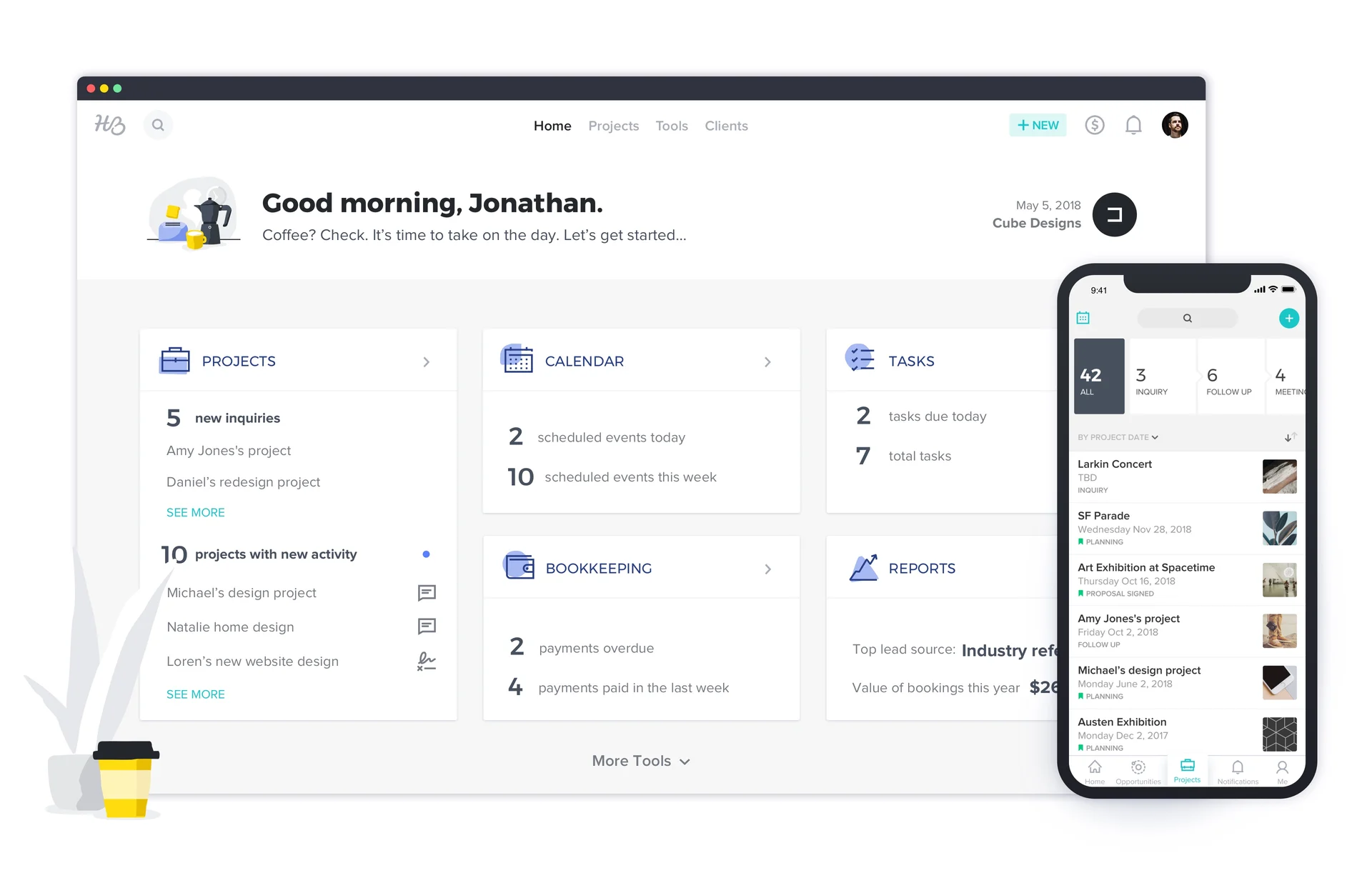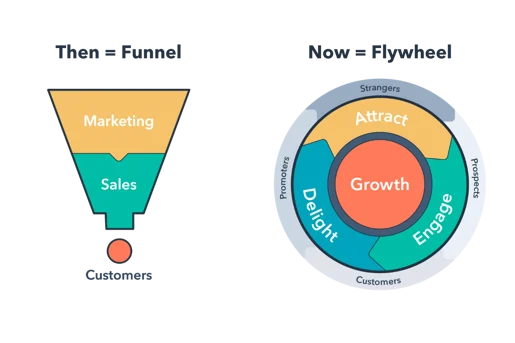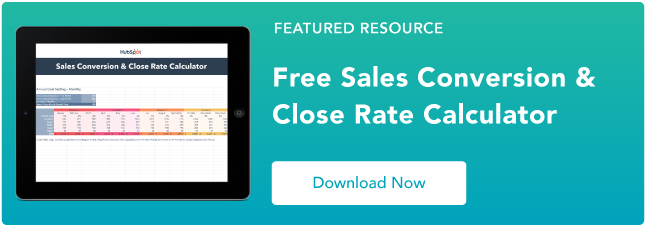For the last fifty years, companies would live or die by the strength of their sales funnel. The premise was simple enough — fill up the top with prospects and convert those who reach the bottom.

But here‘s the rub — the sales landscape is constantly evolving, but the sales funnel hasn’t. The buyer's journey no longer follows a straight highway from awareness to consideration to purchase. In reality, people take a lot of detours.
Now, it's up to sales leaders to reinvent the funnel — or find an alternative. Let’s take a closer look at the sales funnel, see how it differs from a flywheel, and explore which model is right for your business.
Skip to:
What is a sales funnel?
A sales funnel mirrors the path your prospects take to become a customer. It describes discrete stages of the customer journey, from first touch to closed deal.
.png)
Free Sales Pricing Strategy Calculator
Determine the best pricing strategy for your business with this free calculator and template.
- Cost-Plus Pricing
- Skimming Strategy
- Value-Based Pricing
- And More!
A sales funnel starts with a large number of potential buyers at the top. Based on certain criteria, this pool of potential buyers is reduced to a fewer number of prospects.
Towards the middle of the customer journey, the number of prospects reduces to a handful of opportunities — and after the decision-making stage, the sales process ends with a closed-won or closed-lost deal.

As each individual deal moves through each phase, the probability of closing the sale will change. The further along the sales funnel, the more information is exchanged and the more apparent it becomes using the product will be advantageous to the customer.
At this point, there is a higher potential for that deal to be ultimately successful unless the deal is moved to closed-lost — in which case, the probability moves to zero.
During my sales career, I’ve seen the sales funnel solve several problems for sales leadership:
- It was a clearly defined process to model how to close more deals.
- It helped quantify the value of future sales.
- It allowed sales teams to build statistics around the size and the number of deals required to mathematically exceed quota.
- The sales funnel helped define a methodology to teach salespeople how to move customers through a logical sales process and into a closing sequence to maximize rep productivity and cost per lead.
With this definition of a sales funnel in mind, let’s walk through a few real-life sales funnel examples.
Pro tip: Download the free HubSpot sales funnel template to create sales funnel stages and see the funnel stage of each deal.
Sales Funnel Examples
1. Audible

Audible is an Amazon-owned producer of audiobooks and spoken-word entertainment. This platform brings potential subscribers into their sales funnel by promoting a free one-month trial for the service. When users sign up, they're given 30 days to use the service before being automatically enrolled in a monthly subscription.
2. HoneyBook

HoneyBook offers business management software for creative entrepreneurs. Its business personality test lead magnet helps business owners identify their strengths, having participants provide their email addresses to receive their results.
Based on the results of their quiz, they are then added to an email nurturing campaign that provides tailored business advice for their personality type, with the option to begin a trial using HoneyBook.
Now let’s discuss how to create your own sales funnel, and if using a sales funnel is the right approach for your business.
How to Create a Sales Funnel
- Define the problem you want to solve for your customers.
- Define your goals.
- Create a preliminary offer to generate leads.
- Qualify leads to confirm interest in the product.
- Nurture your qualified leads.
- Close the deal.
- Track the final results and analyze sales data.
1. Define the problem you want to solve for your customers.
For your sales funnel to work, you need to understand your audience. What are their pain points? Expectations? Interests? The more insight you have, the better you can position your products and create intriguing offers.
2. Define your goals.
Now, it‘s time to define your goals. This could include more leads, product demos, e-newsletter sign ups, or purchases. Goals let you determine what you want from each stage in your funnel — which is critical for measuring whether it’s working or not.
3. Create a preliminary offer to generate leads.
It goes without saying, but before you can convert prospects, you need to attract their attention. Consider what offers can generate interest — such as a free trial or an ebook in exchange for contact info.
4. Qualify leads to confirm interest in the product.
Not all leads are created equal. Some may show interest, but aren't a good fit for your company — and vice versa. For instance, a prospect may sign up for your e-newsletter, but they don't fit your customer profile.
You'll need to determine what a qualified lead looks like, then follow-up with those who meet your criteria.
5. Nurture your qualified leads.
Picture this — a prospect visits your website. They click around, even filling out a form with their contact info. Then, they go radio silent. Does this sound familiar? If so, it's time to focus on lead nurturing.
While most lead nurturing involves a simple email drip campaign — you have a variety of other channels at your disposal, such as social media or paid retargeting.
Regardless of the vehicle you choose, it's essential to offer something that can nudge them closer to making a decision, such as an extended trial or special discount. The goal here is to remove as much friction as possible and encourage leads to move down the funnel.
6. Close the deal.
At this point in the funnel, the lead has either become a customer or decided not to make the purchase. In either case, it's important to keep the communication lines open.
For customers, you need to shift your efforts to retention and building loyalty. And for those who didn't convert, return to your nurturing strategy and reach out every few months. While they may not convert now, this could change down the road.
.png)
Free Sales Pricing Strategy Calculator
Determine the best pricing strategy for your business with this free calculator and template.
- Cost-Plus Pricing
- Skimming Strategy
- Value-Based Pricing
- And More!
7. Track the final results and analyze sales data.
Even the most qualified leads can fall through the cracks in your funnel. The best way to prevent this is by looking for blind spots, missed opportunities, and areas for improvement. Remember your sales funnel isn't set in stone — it needs to be optimized continually.
Luckily optimizing your sales pipeline is simplified using HubSpot’s free pipeline management software. With it, you can track quota attainment, discover trends, and tailor your pipeline to your customer’s needs.
Sales Funnel vs. Flywheel
The modern sales process has changed dramatically in the last few years — and those changes make the traditional sales funnel obsolete.
Today, customers are in control of the sales process. A modern buyer spends more time upfront researching a purchase before they engage with a salesperson, reducing the value of sharing information.
Armed with extensive online information, a modern buyer requires different skills from a salesperson and frequently exhibits different behavior than buyers of the past. A modern buyer may get very excited about a purchase and spend a lot of time in the research phase and then abruptly stop, ending the sales process — sometimes without any reason at all.
These behaviors are why some companies leverage a flywheel instead of a sales funnel.

The flywheel is a model adapted by HubSpot to explain the momentum you gain when you align your entire organization around delivering a remarkable customer experience — one that produces happy customers who drive referrals and repeat sales.
How does the flywheel work?
To get your flywheel spinning you need to add force to it by making significant investments in strategies to acquire and retain customers.
Once you acquire enough initial customers and you ensure their success and happiness, they become a force for your flywheel. This is because they either buy from you again or bring in new customers by promoting you to their network. This is the key to keeping your flywheel spinning without investing all your resources in acquiring new customers.
In other words, rather than having your sales team explain your products or services, you use the momentum of your happy customers to drive referrals and repeat sales.
Using a flywheel, you can build a community or ecosystem of customers who help other customers. For a modern sales process, a flywheel is better than a sales funnel because it leverages current customers to attract and engage new prospects.
How to Build a Flywheel
1. Understand your current customers are more powerful than any other influence.
Prospects trust the stories and experiences of your current customer base. In fact, 46% of consumers trust an online review as much as a personal recommendation. Leverage this by making sure you have lots of use cases, customer testimonials, and references that showcase your current clients explaining your product or service’s strengths.
2. Have your strong customers create social proof.
Social proof is the psychological idea that people determine what’s correct by finding out what other people think is correct. Customer reviews are 12x more trusted than descriptions that come from manufacturers. Social media is a powerful tool for creating social proof. Let the stories and experiences of your happy customers create converting content for you.
3. Identify areas of force and friction.
Force moves the sales process forward. Areas of force include accurate and timely information, a good understanding of the problem, your ability to listen, and overall responsiveness.
On the flip side, friction slows down the sales process. Essentially, when your prospect has to jump through too many hoops or faces obstacles or inconveniences throughout the sales process, this creates friction which makes your job more difficult.
By identifying areas of force and friction, you can double-down on the activities that will bring more momentum to your ability to drive the sale, and remove unnecessary obstacles to create a frictionless experience. This will keep the flywheel moving forward and make your buyers happy.
Flywheel Model Drives Sales
If you continue to delight existing customers, going with a flywheel model may be more advantageous than a traditional sales funnel. Delighted customers drive referrals and repeat sales — allowing your brand to continue to attract new clientele without having to devote all of your resources to do so.
Editor’s note: This article was originally published in June 2022 and has been updated for comprehensiveness.
![Download Now: Sales Conversion Rate Calculator [Free Template]](https://no-cache.hubspot.com/cta/default/53/059a7eef-8ad9-4bee-9c08-4dae23549a29.png)


![22 Best Sales Strategies, Plans, & Initiatives for Success [Templates]](https://blog.hubspot.com/hubfs/Best-Sales-Strategies-1.png)

![7 Social Selling Trends to Leverage This Year [New Data]](https://blog.hubspot.com/hubfs/social%20selling%20trends.png)
![How Do Buyers Prefer to Interact With Sales Reps? [New Data]](https://blog.hubspot.com/hubfs/person%20phone%20or%20online%20sales%20FI.png)
![7 Sales Tips You Need to Know For 2024 [Expert Insights]](https://blog.hubspot.com/hubfs/Sales%20Tips%202024%20FI.png)


![10 Key Sales Challenges for 2024 [+How You Can Overcome Them]](https://blog.hubspot.com/hubfs/sales%20challenges%20FI.png)
![The Top Sales Trends of 2024 & How To Leverage Them [New Data + Expert Tips]](https://blog.hubspot.com/hubfs/sales-trends-2023.png)